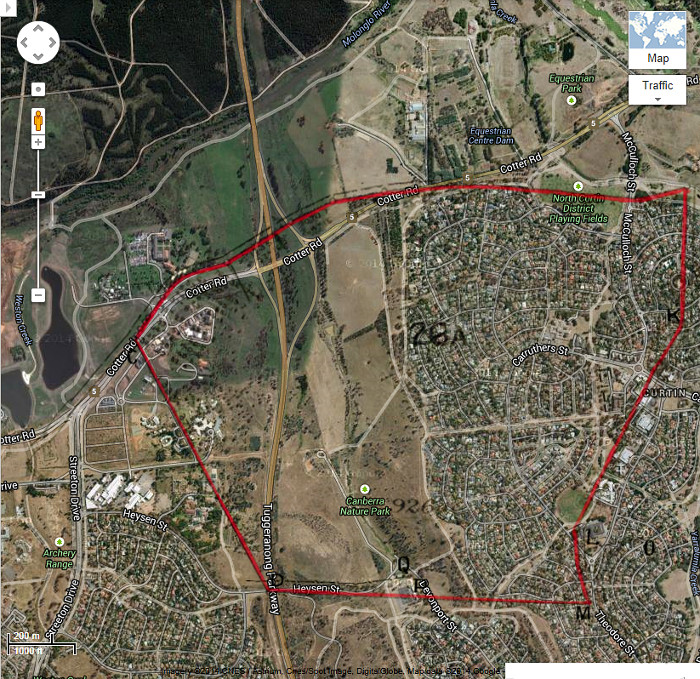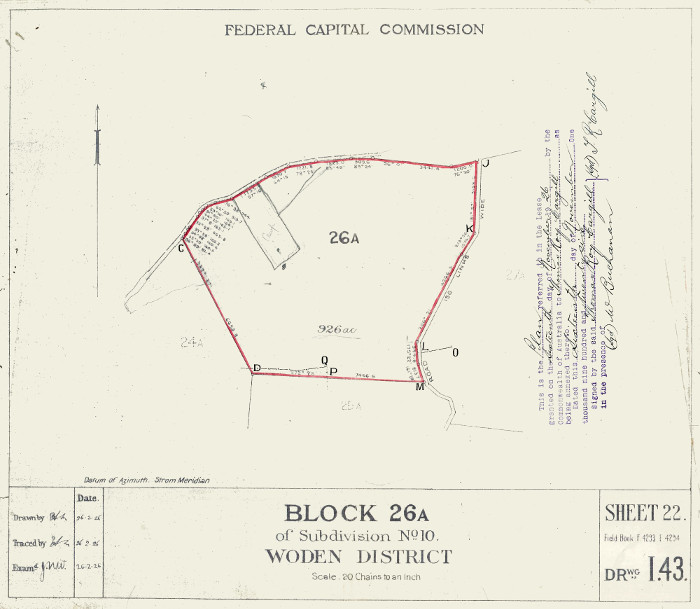Thomas Roy Cargill
Blocks 40 & 26A Woden District – Property Name: 'Illoura'
Thomas Roy Cargill was born near Mongarlowe (to the east of Braidwood, NSW) on the 14th May 1881. He enlisted in Goulburn, NSW in 1915 and arrived in Egypt in December 1915. Cargill was sent to France in March 1916 where he served with the 22nd Field Artillery Brigade. He was awarded the Military Medal for his actions on the 18th May 1917 while assisting to extinguish a fire in an ammunition dump. He was wounded during the Third Battle of Ypres in September 1917. After recovering from his wounds he served the rest of the war with the 4th Field Artillery Brigade.
Block 40 Woden
Cargill was living and working in the Uriarra area when he heard that he had been allocated Woden Block 40 in April 1924. The Land Board approved the reallocation of Woden Block 40 that was previously leased to John (Jack) Donnelly. The block had been reduced in size from 772 acres (312 hectares) to 660 acres (267 hectares).

Google Maps image of area c2014 with Woden Block 40 boundary in red.
The lease, for which he paid £154/9/4 in annual rent, was only short term and expired in November 1925. The block included a 10 x 16 feet (3 x 4.9 metres) galvanised iron hut that had been used as the mess for the No.1 Sewer Camp during construction of Canberra’s Main Outfall Sewer. Cargill successfully asked if he could use the hut to live in.
Block 26A Woden
The lease on Woden Block 40 terminated on the 31st December 1925. Cargill was then offered a ten-year lease on the much larger Woden Block 26A, which included the land previously designated as Woden Block 40.
Plan of Woden Block 26A. Click on plan for larger view.
The lease on Woden Block 26A commenced on the 1st January 1926 at a rent of £304/4 per annum. Maps show the block as being 1015 acres (411 hectares) but the lease documents state the size as 926 acres (375 hectares). A portion of the block fronting the Cotter Road was still occupied as a campsite by workers at the Westridge Outfall Sewer Camp. Cargill successfully complained that his rent should be reduced to account for the land being used as a camp.
During 1927, the Westridge Outfall Sewer Camp was included into Woden Block 26A. Two families, Bellchambers and Blewitt, who had been camping in humpies on the site, were given notice to move on. Bellchambers was a maintenance man and Blewitt operated a horse and dray at the sewerage works. The men were still there in November 1927 when Cargill successfully claimed that any rent they paid should be credited to him as the camp was within his lease.
Cargill allowed the Varena family from Braidwood to operate the former No.1 Sewer Camp mess building as a boarding house. Cargill and two other soldier settlers, Jack Maguire from Woden Block 25A and David Tully from Belconnen Block 52B, were boarders. In January 1927, he was advised that the boarding house was in breach of his lease and it closed by the end of that month. Cargill asked to keep using the building as a residence as it was occupied by an employee and his family, who was erecting fences. In April 1927, the Commonwealth advised they would not insist upon its removal but may do so in the future.
It was around this time that Cargill began referring to his lease as Illoura in official correspondence.

Google Maps image of area c2013 with Woden Block 26A boundary in red.
Cargill believed that the block was too small to make a living and applied to sell the lease to Guy Tanner in January 1928. The Commonwealth agreed to this on the 24th February 1928. Cargill returned to the Braidwood district where he married Miss Lydia Cane in 1936. He died in Braidwood on the 21st November 1964.
Sources
- ArchivesACT: Government Property & Tenancy Registers - Woden Block 26A (
 PDF 413Kb)
PDF 413Kb) - ArchivesACT: Rate Book : Territory for the Seat of Government - 1927 (
 PDF 17.8Mb)
PDF 17.8Mb) - ArchivesACT: TL917 (Part 1) - Block 26A Woden - G.D.C. Tanner
- NAA: (A192) FCL1924/486 Block 40 Woden
- NAA: (A361) DSG24/727 Block 40 Woden TR Cargill
- NAA: (A363) DSL19211/1048 Block 40 Woden JF Donnelly
- NAA: (B2455) First Australian Imperial Force Personnel Dossiers, 1914-1920: http://discoveringanzacs.naa.gov.au/browse/person/112388
- Monaro Pioneers Index: http://www.monaropioneers.com
- Wedding Bells - The Braidwood Dispatch and Mining Journal, 10 July 1936, p.2: http://nla.gov.au/nla.news-article119368865

